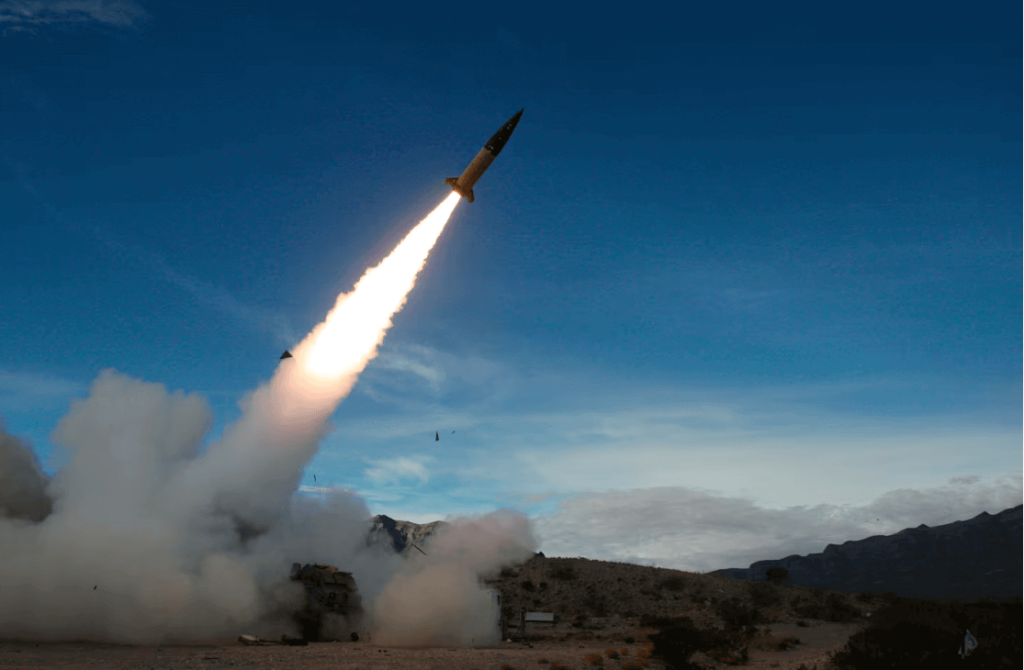【中美创新时报2024 年 11 月 17 日编译讯】(记者温友平编译)美国官员表示,总统乔·拜登已授权乌克兰首次使用美国提供的远程导弹对俄罗斯境内进行打击。《纽约时报》记者亚当·恩图斯、埃里克·施密特和朱利安·E·巴恩斯对此作了下述报道。
官员们说,这些武器很可能首先用于对付俄罗斯和朝鲜军队,以保卫俄罗斯西部库尔斯克地区的乌克兰军队。
拜登的决定是美国政策的重大变化。这一选择使他的顾问们产生了分歧,他的转变发生在当选总统唐纳德·特朗普上任前两个月,特朗普曾誓言要限制对乌克兰的进一步支持。
官员们表示,允许乌克兰使用这种被称为陆军战术导弹系统(ATACMS)的远程导弹是对俄罗斯突然决定让朝鲜军队参战的回应。
5 月,俄罗斯对乌克兰第二大城市哈尔科夫发动跨境攻击后,拜登开始放松对在俄罗斯领土上使用美国供应武器的限制。
为了帮助乌克兰人保卫哈尔科夫,拜登允许他们使用射程约 50 英里的高机动性火炮火箭系统(HIMARS)对付边境对面的俄罗斯军队。但拜登不允许乌克兰人使用射程更远的 ATACMS 来保卫哈尔科夫,其射程约为 190 英里。
虽然官员们表示,他们并不认为这一转变会从根本上改变战争进程,但他们表示,政策变化的目标之一是向朝鲜发出一个信息,即他们的军队很脆弱,不应派遣更多军队。
官员们表示,虽然乌克兰人可能会首先使用导弹对付威胁库尔斯克乌克兰军队的俄罗斯和朝鲜军队,但拜登可以授权他们在其他地方使用这些武器。
一些美国官员表示,他们担心乌克兰越过边境使用导弹可能会促使俄罗斯总统普京对美国及其联盟伙伴进行武力报复。
但其他美国官员表示,他们认为这些担忧被夸大了。
俄罗斯军方将发动大规模进攻,约有 5 万名士兵(包括朝鲜军队)将对库尔斯克的乌克兰阵地发动进攻,目标是夺回乌克兰人在 8 月占领的所有俄罗斯领土。
乌克兰人可以使用 ATACMS 导弹袭击俄罗斯和朝鲜的军队集结地、关键军事装备、后勤节点、弹药库和俄罗斯境内的补给线。
这样做可以帮助乌克兰人削弱俄朝攻击的效力。
自 2022 年 2 月俄罗斯全面入侵乌克兰以来,是否用远程 ATACMS 武装乌克兰一直是一个特别敏感的话题。
一些五角大楼官员反对将这些导弹交给乌克兰人,因为他们说美国陆军的补给有限。 一些白宫官员担心,如果他们把导弹交给乌克兰人,普京会扩大战争。
支持对莫斯科采取更积极姿态的人说,拜登和他的顾问太容易被普京的敌对言论吓倒了,他们说,政府对武装乌克兰人的渐进式方法使他们在战场上处于不利地位。
支持拜登做法的人表示,这种方法在很大程度上成功地避免了俄罗斯的暴力反应。
允许使用美国导弹对俄罗斯领土进行远程打击可能会改变这一局面。
8 月,乌克兰人发动了自己的跨境袭击,袭击了库尔斯克地区,占领了大片俄罗斯领土。
从那时起,美国官员越来越担心乌克兰军队的状况,俄罗斯同时袭击东部的哈尔科夫和现在的库尔斯克,乌克兰军队已经捉襟见肘。
超过 10,000 名朝鲜士兵的加入和拜登的回应发生在特朗普准备重新上任之际,特朗普的目标是迅速结束战争。
特朗普几乎没有透露他将如何解决冲突。但当选副总统 JD Vance 概述了一项计划,该计划将允许俄罗斯保留其军队占领的乌克兰领土。
乌克兰人希望,在未来的谈判中,他们能够用他们在库尔斯克控制的任何俄罗斯领土来交换俄罗斯控制的乌克兰领土。
如果俄罗斯对库尔斯克乌克兰军队的袭击成功,乌克兰最终可能几乎没有俄罗斯领土可以与莫斯科进行交易。
乌克兰总统泽连斯基长期以来一直寻求美国及其联盟伙伴的许可,使用远程导弹袭击俄罗斯领土。
英国和法国军方向乌克兰人提供了有限数量的“风暴阴影”和“SCALP”导弹,这些导弹的射程约为 155 英里,低于美国的导弹系统。
虽然英国和法国领导人表示支持泽连斯基的请求,但他们不愿允许乌克兰人在俄罗斯领土上使用导弹,除非拜登同意允许乌克兰人使用 ATACMS。
与英国和法国同行相比,拜登更厌恶风险,他的高级顾问们对如何推进存在分歧。
其中一些人抓住了最近的美国情报评估,该评估警告称,普京可能会对俄罗斯境内使用远程 ATACMS 做出回应,指示俄罗斯军方或其间谍机构对美国及其欧洲盟友进行报复,甚至可能使用致命武力。
该评估警告称,俄罗斯可能采取几种回应措施,包括加强针对欧洲设施的纵火和破坏行为,以及对美国和欧洲军事基地进行可能致命的袭击。
官员们表示,拜登之所以做出这一改变,部分原因是俄罗斯决定将朝鲜军队派往乌克兰防线,这太大胆了。
他们说,拜登还担心,如果不允许乌克兰军队使用远程武器自卫,俄罗斯突击部队将能够压倒库尔斯克的乌克兰军队,这也影响了拜登的立场。
美国官员表示,他们不认为这一决定会改变战争的进程。
但他们表示,拜登认为,潜在的好处——乌克兰将能够打击某些原本无法打击的高价值目标,而美国将能够向朝鲜发出信息,表明它将为参与其中付出巨大代价——超过了升级风险。
一年前,当美国情报机构得知朝鲜将向俄罗斯提供远程弹道导弹时,拜登也面临类似的困境。
当时,拜登同意向乌克兰提供数百枚远程 ATACMS 导弹,用于乌克兰主权领土,包括俄罗斯占领的克里米亚半岛。这些导弹补充了乌克兰从英国和法国获得的较为有限的 Storm Shadow 和 SCALP 导弹供应。
此后,乌克兰人使用其中许多导弹对克里米亚和黑海的俄罗斯军事目标进行了协同打击。
因此,目前尚不清楚乌克兰军火库中还剩下多少枚导弹可供库尔斯克地区使用。
本文最初发表于《纽约时报》。
题图:美国陆军人员在新墨西哥州白沙导弹靶场试射 ATACMS 导弹。约翰·汉密尔顿/美联社
附原英文报道:
Biden allows Ukraine to strike Russia with long-range US missiles
By Adam Entous, Eric Schmitt and Julian E. Barnes New York Times,Updated November 17, 2024
A test firing by US Army personnel of an ATACMS missile at White Sands Missile Range, N.M.John Hamilton/Associated Press
WASHINGTON — President Joe Biden has authorized the first use of U.S.-supplied long-range missiles by Ukraine for strikes inside Russia, U.S. officials said.
The weapons are likely to be initially employed against Russian and North Korean troops in defense of Ukrainian forces in the Kursk region of western Russia, the officials said.
Biden’s decision is a major change in U.S. policy. The choice has divided his advisers, and his shift comes two months before President-elect Donald Trump takes office, having vowed to limit further support for Ukraine.
Allowing the Ukrainians to use the long-range missiles, known as the Army Tactical Missile Systems, or ATACMS, came in response to Russia’s surprise decision to bring North Korean troops into the fight, officials said.
Biden began to ease restrictions on the use of U.S.-supplied weapons on Russian soil after Russia launched a cross-border assault in May in the direction of Kharkiv, Ukraine’s second-largest city.
To help the Ukrainians defend Kharkiv, Biden allowed them to use the High Mobility Artillery Rocket System, or HIMARS, which have a range of about 50 miles, against Russian forces directly across the border. But Biden did not allow the Ukrainians to use longer-range ATACMS, which have a range of about 190 miles, in defense of Kharkiv.
While the officials said they do not expect the shift to fundamentally alter the course of the war, one of the goals of the policy change, they said, is to send a message to the North Koreans that their forces are vulnerable and that they should not send more of them.
The officials said that while the Ukrainians were likely to use the missiles first against Russian and North Korean troops that threaten Ukrainian forces in Kursk, Biden could authorize them to use the weapons elsewhere.
Some U.S. officials said they feared that Ukraine’s use of the missiles across the border could prompt President Vladimir Putin of Russia to retaliate with force against the United States and its coalition partners.
But other U.S. officials said they thought those fears were overblown.
The Russian military is set to launch a major assault by an estimated 50,000 soldiers, including North Korean troops, on dug-in Ukrainian positions in Kursk with the goal of retaking all of the Russian territory that the Ukrainians seized in August.
The Ukrainians could use the ATACMS missiles to strike Russian and North Korean troop concentrations, key pieces of military equipment, logistics nodes, ammunition depots and supply lines deep inside Russia.
Doing so could help the Ukrainians blunt the effectiveness of the Russian-North Korean assault.
Whether to arm Ukraine with long-range ATACMS has been an especially sensitive subject since Russia’s full-scale invasion of Ukraine in February 2022.
Some Pentagon officials opposed giving them to the Ukrainians because they said the U.S. Army had limited supplies. Some White House officials feared that Putin would widen the war if they gave the missiles to the Ukrainians.
Supporters of a more aggressive posture toward Moscow say Biden and his advisers have been too easily intimidated by Putin’s hostile rhetoric, and they say that the administration’s incremental approach to arming the Ukrainians has disadvantaged them on the battlefield.
Proponents of Biden’s approach say that it had largely been successful at averting a violent Russian response.
Allowing long-range strikes on Russian territory using U.S. missiles could change that equation.
In August, the Ukrainians launched their own cross-border assault into the Kursk region, where they seized a swath of Russian territory.
Since then, U.S. officials have become increasingly concerned about the state of the Ukrainian army, which has been stretched thin by simultaneous Russian assaults in the east, Kharkiv and now Kursk.
The introduction of more than 10,000 North Korean troops and Biden’s response come as Trump prepares to reenter office with a stated goal of quickly ending the war.
Trump has said little about how he would settle the conflict. But Vice President-elect JD Vance has outlined a plan that would allow the Russians to keep the Ukrainian territory that their forces have seized.
He was also swayed, they said, by concerns that the Russian assault force would be able to overwhelm Ukrainian troops in Kursk if they were not allowed to defend themselves with long-range weapons.
U.S. officials said they do not believe that the decision will change the course of the war.
But they said Biden determined that the potential benefits — Ukraine will be able to reach certain high-value targets that it would not otherwise be able to, and the United States will be able to send a message to North Korea that it will pay a significant price for its involvement — outweighed the escalation risks.
Biden faced a similar dilemma a year ago when U.S. intelligence agencies learned that the North Koreans would supply Russia with long-range ballistic missiles.
In that case, Biden agreed to supply several hundred long-range ATACMS to the Ukrainians for use on Ukraine’s sovereign territory, including the Russian-occupied Crimean Peninsula. Those supplemented the more limited supplies of Storm Shadow and SCALP missiles that the Ukrainians received from Britain and France.
The Ukrainians have since used many of those missiles in a concerted campaign of strikes against Russian military targets in Crimea and in the Black Sea.
As a result, it is unclear how many of the missiles the Ukrainians have left in their arsenal to use in the Kursk region.
This article originally appeared in The New York Times.

